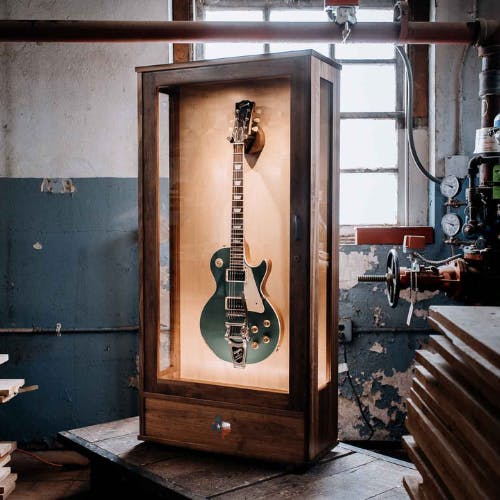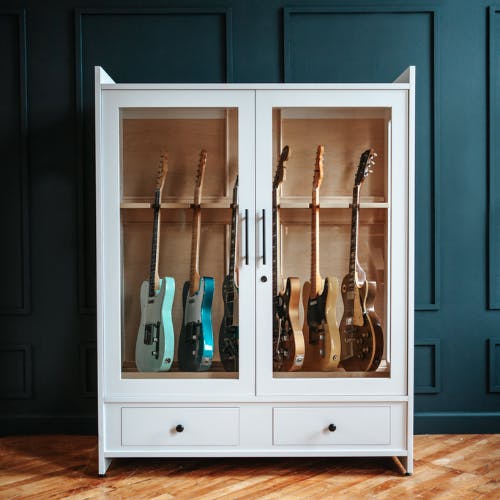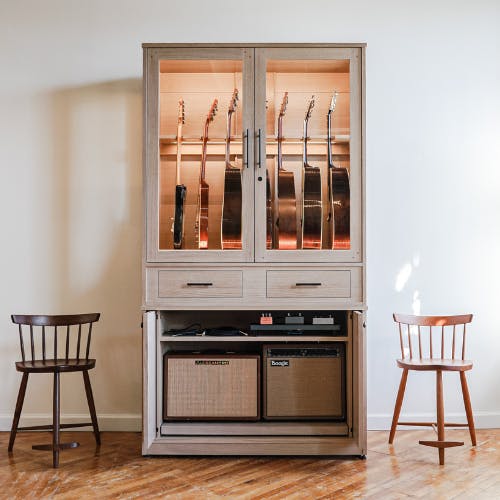Guitar Humidity: Everything You Need To Know
Temperature fluctuations throughout the year coincide with humidity changes around the country. As a result, these changes will undoubtedly affect your instruments and can seriously damage them if not cared for properly. This article outlines the ideal humidity for your guitars year-round. It will also educate you on the tools necessary to remedy acoustic guitar humidity problems.
What Is Humidity?
First, it’s important to understand what humidity is. Relative humidity (usually just referred to as humidity) is the measurement of the current amount of water vapor in the air. Have you ever walked outside and felt that the air was wet or “heavy?” This is what a higher level of humidity feels like. This occurs because the higher the temperature, the more moisture the atmosphere can hold. When you check your phone’s weather app and see the humidity percentage, this measurement is what you need to control wherever you store your instruments.
Why Guitar Humidity Matters:
Next, we will discuss why you need to monitor the humidity levels surrounding your guitars. More often than not, the culprit of guitar damage is a humidity-related issue. This will often result in top cracks, side cracks, neck issues, or other costly damage. And yes, humidifying your electric guitars is crucial too. We know this from many years of experience working with guitar repair experts, musicians, and collectors who purchase our products after humidity has damaged one of their instruments. Fortunately, these issues are preventable.
The Ideal Guitar Humidity:
Now we will discuss the ideal guitar humidity. Your goal is to maintain a humidity level of 45% at 70°F year round wherever you store your guitars. That being said, between 40% – 60% year-round is safe for your instruments. Particularly in the Northeast, the Autumn & Spring months produce some of the largest fluctuations in temperature and humidity. If you live in a similar climate, you too may notice humidity levels changing often during that time. If you reside in a desert or mountain climate, you will typically need to humidify your instruments more year-round. We suggest isolating your instruments as much as possible from these changes. Doing so aids in keeping the humidity level stable during those transitional months.
Signs Of Guitar Humidity Problems:
Next, you need to be aware of the signs of guitar humidity issues. Do you notice a single sharp fret on one of your guitars? This alone is not usually caused by humidity problems. However, multiple sharp frets or a combination of the issues below can be a sign of a guitar humidity issue developing. Below is a list of symptoms that answer the question, “How do I know if my guitar is over-humidified or under-humidified?”
Over-Humidified (Wet):
- High Action: Strings are further away from the fretboard than usual.
- Swelling: Also known as bellying, raised wood behind the bridge. This is typical with acoustics & archtops.
- Oxidized Frets: The frets on your acoustic or electric guitar show signs of rust (brown) and often feel like sandpaper when bending notes.
- Topwood Seam Splits: Typically affect acoustic guitars starting behind the bridge with straight line cracks.
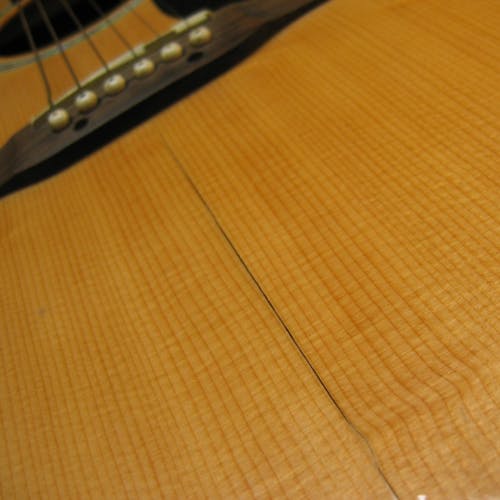

Under-Humidified (Dry):
- Fret Buzzing: While fretting a note you hear an audible buzz, often caused by lack of humidity if the buzz is happening at the fingerboard extension.
- Sharp Frets: This occurs when your acoustic or electric guitar neck shrinks due to a lack of humidity in the porous wood.
- Topwood Seam Splits: This can result from both over & under-humidification on acoustic guitars behind the bridge.
- Caved-in Top: Opposite of bellying, where the lack of humidity has caused the wood behind the bridge to dip inward into the guitar body.
- Side Cracks: This commonly occurs when the top wood shrinks, pulling the seams of the sides away from each other.
Tom Crandall is widely known as one of the most knowledgeable & trusted guitar repair experts in the world. This video is another great source for the effects of humidity on acoustic guitars.
Tools For Guitar Humidity Control:
Now that you know what humidity is, why it matters, and how to be aware of humidity issues, next, we will cover some of the tools you should consider to maintain and monitor guitar humidity while traveling and at home.
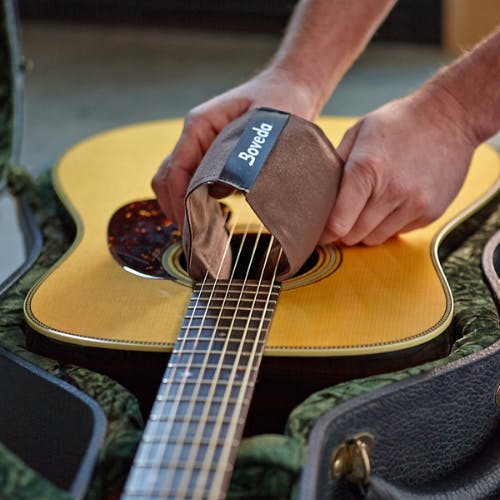

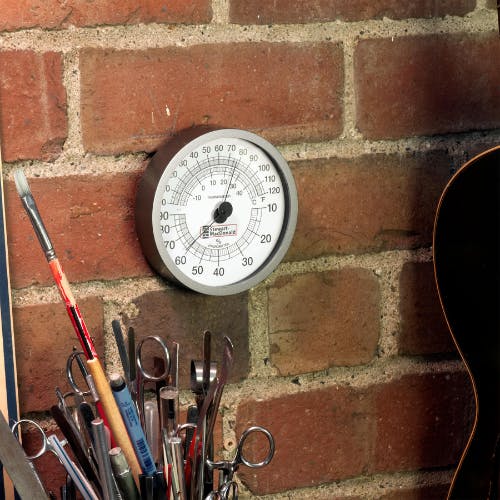
Boveda is a newer company that has joined the guitar and wood instrument humidification space, quickly gaining popularity via its 2-way humidification system. This product can be utilized in an instrument travel case. They are also a very popular choice as an acoustic guitar humidifier system, adjusting to a safe 49% RH.
Long-time string and guitar accessory giant D’Addario has created some of the most popular options for travel case humidity control and monitoring including chemical humidification packs and hygrometers. Their battery-powered hygrometers display both the humidity level and temperature.
Luthier supplier & trusted brand, StewMac has been a reliable source for parts, woods, and other necessities including their analog display hygrometer & thermometer. This is a great at-home monitoring tool for those storing their instruments in a small room. It is also good to have as a secondary reference & comparison tool.
| American Music Furniture |
Music-Inspired Designs For Guitar Preservation & Display
Our Nashville Habitat is a wall-mounted guitar display case that humidifies, preserves and displays your best guitar. A great choice for a single display at home or in the office.
Our Guitar Habitat is an instrument display case and guitar humidor that actively humidifies, dehumidifies, preserves and displays up to ten guitars. Offered in a variety of locally sourced solid woods, this guitar cabinet ensures easy access to your guitars and only requires refilling monthly.
Our flagship model, the Guitar Estate, is the pinnacle of instrument preservation & convenience tailored to your needs. This guitar storage cabinet is fully customizable with the ability to house up to ten guitars in the top portion with options including a sliding amp tray, adjustable shelves, drawers, and more below.
Questions You Need To Consider:
Lastly, below are some of the most important questions you need to consider going forward to properly humidify, protect, and preserve your guitar & wood instrument collection.
How often are you away from your guitar collection?
Do you travel often for long periods of time? Do you have someone to monitor your collection while you’re away? If this applies to you, chemical humidity packs or small room humidifiers are not the safest, most reliable, or cost-effective solution in the long run. These options necessitate constant refilling and monitoring of your collection to avoid humidification problems from humidity fluctuations.
Are you using a soundhole humidification system that utilizes water?
These tools are typically used to remedy acoustic guitar humidity issues but beware of over-humidification and spills. A single drop of water in an acoustic guitar’s soundhole will be absorbed by the wood, causing it to expand. As a result, it can severely damage your guitar.
Do you use a large room humidifier?
Do you have a guitar room that utilizes a freestanding humidification system with water? Does the unit have an automatic shut-off sensor to avoid over-humidification? Are you operating the unit with distilled water or tap water? Tap water contains high mineral content, which can oxidize frets, and also leave a white dusty residue around the room. Furthermore, the wick (internal filter) can grow mold and will calcify over time. Distilled water does remove the issue of mineral content. However, this setup makes the humidifier more susceptible to mold growth inside the water tank and will require more regular maintenance to avoid bacterial growth. We suggest utilizing distilled water as much as possible. However, it is important to note that both types of water will be easily absorbed by sheetrock, which can cause hidden mold growth behind walls. Overall, room humidification systems are a common choice for multiple guitar humidity control when monitored and used correctly. If you choose to go this route, be sure your humidifier is sized correctly for your space, and also use another hygrometer as a secondary humidity level reading. Lastly, this option may not be the best choice for those who require low noise (such as a recording studio) or those who store their instruments in a space that suffers from high air drafts, leaky windows, or is poorly sealed.
Conclusion & Recap:
- Humidity is going to fluctuate often during Spring & Fall in most locations.
- Maintain 45% humidity wherever you store your guitars.
- 40% – 60% humidity is safe throughout the year at 70°F.
- Know the signs of guitar humidity problems to avoid damage.
- Know what humidification system works best for your life & home.
- Utilize the proper tools while traveling and at home to monitor humidity year-round.
We believe that displaying your guitars and storing them safely breeds creativity. Our goal at American Music Furniture has always been to provide the premier solution for combining the safest, most accurate guitar humidity control system & storage display in one. Our guitar humidors address both issues with the ability to humidify & dehumidify automatically within the same space, while also displaying them in beautifully handcrafted solid-wood & glass enclosures.
Our music-inspired designs allow you the musician, to do what you do best – play your guitars. When you’re away from them, you have peace of mind knowing that our guitar display cabinets only require a refill every 4-6 weeks. These handmade guitar display cases remove the need for room humidifiers, humidity packs, hygrometers, and other tools. Doing so puts you in touch with your favorite instruments more often. When humidified correctly, it maintains its playability while also protecting its value.
Ready to get serious about guitar humidity and storage? Want to learn more about solutions for displaying a guitar such as custom built-ins, guitar stands, guitar wall hangers, and more? Interested in what a guitar humidor would look like in your home or music space? Contact us today for the most reliable humidified guitar display cabinet solutions handmade in America. (267) 272-2460
